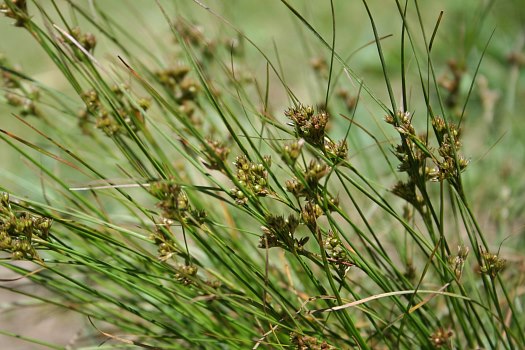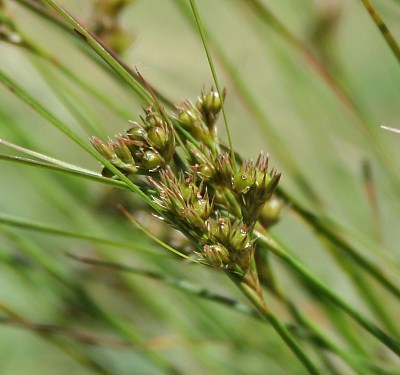Description: This perennial rush is typically 4-12" tall. It is often densely tufted with erect to ascending stems that are light to medium green, slender, glabrous, and unbranched. The leaves of each stem are basal or nearly so. The narrow leaf blades are about 1 mm. across and up to 10" long; they are ascending or curve gently away from the stems. The leaf blades are medium green, glabrous, and flat to slightly involute (with margins that roll upward). The sheaths of young leaves are light green with membranous upper margins; later they become tan to brown and often somewhat shredded. At its apex, each sheath has a pair of soft membranous auricles (ear-like extensions) that are lanceolate in shape. Each fertile stem terminates in a branching inflorescence at its apex that is about ½–3" across; this inflorescence has one or more umbel-like clusters of chaffy flowers. There are usually fewer than 10 flowers per cluster. At the base of this inflorescence, there are about 3 slender leafy bracts up to 4" long that form a V-shape; the larger bracts extend beyond the inflorescence. Each flower has 3 scaly petals, 3 scaly petals, several stamens, and a superior ovary (later a seed capsule). The petals and sepals are nearly identical in appearance; they are about 3-5 mm. long and lanceolate in shape. Young petals and sepals are light green (sometimes with reddish tips), but they later become tan; as the flower matures, they spread slightly away from the ovary/capsule. At the base of each flower, there are tiny bractlets; they are ovate to lanceolate in shape.

The blooming
period usually occurs during the summer; however, 1st year plants may
bloom later during the fall. The flowers are wind-pollinated. The seed
capsule of each flower is ovoid with a small point at its apex; it is
either the same length as the persistent sepals and petals, or a little
shorter than them. Each capsule eventually splits apart into 3 segments
to release its tiny dust-like seeds. The seeds are less than 0.5 mm.
long, ovoid or ellipsoid, and somewhat flattened; each seed tapers to a
tiny point at each end. The root system is fibrous.
Cultivation:
Typical growing conditions include full sun to light shade, wet to
mesic levels of moisture, and a heavy clay-loam, clay, or gravelly
soil. This rush withstands considerable trampling in paths and
compacted soil. It is more tolerant of drought than many other rushes.
Range & Habitat:
The native Path Rush occurs in every county of Illinois and it is very
common (see
Distribution
Map). Habitats include open woodlands, gravelly seeps, foot
paths with compacted soil (where it is especially common), pastures and
abandoned fields, gravelly margins of roadways, and barren waste areas.
This weedy species prefers disturbed habitats. It has spread from North
America to other continents, including Eurasia and Australia.

Faunal
Associations:
Miscellaneous insects feed on various Juncus spp.
(see Insect
Table). It is possible that some upland gamebirds and
granivorous songbirds feed on the seedheads of Path Rush to a limited
extent, but very little information about this is available. With
maturity, the foliage of Path Rush becomes stringy and tough;
therefore, it is usually avoided by mammalian herbivores. Because the
tiny seeds become sticky when wet, they cling readily to the feathers
of birds, fur of mammals, shoes of humans, and tires of motor vehicles;
by this means, they are distributed to new locations. This is one
reason why the Path Rush is often observed along paths and roadways.
Photographic Location:
Along a foot path at Meadowbrook Park in Urbana, Illinois.
Comments:
The Path Rush is one of the more common Juncus spp.,
but it is rather small in size and inconspicuous. Many different forms
of the Path Rush have been described that freely intergrade. Other
similar rushes include Juncus interior (Inland
Rush) and Juncus dudleyi (Dudley's Rush), although
these latter two species are usually larger in size. These rushes can
be distinguished by examining the apex of their basal sheaths. The Path
Rush has an auriculate sheath with a pair of lanceolate extensions that
are membranous and fragile. The sheath of the Inland Rush has a pair of
short auricles that are soft and rounded, while the sheath of Dudley's
Rush has a pair of short auricles that are hard (cartilaginous) and
rounded.